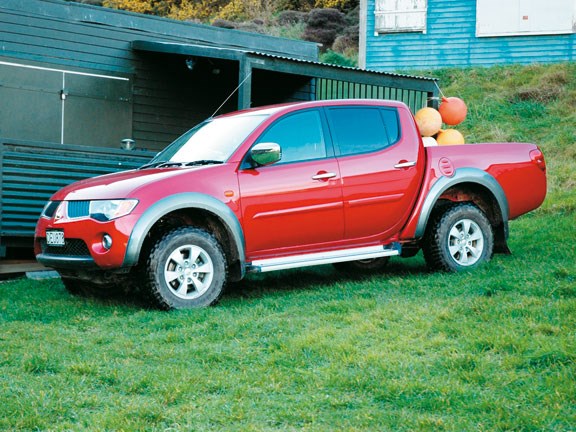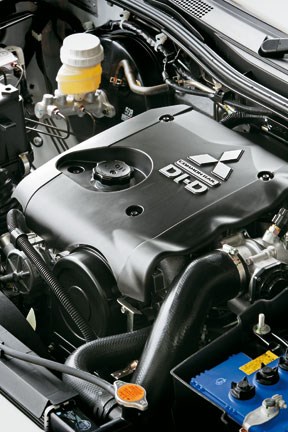Mitsubishi Triton









|

|

|

|
Torque of the country

|
|
Mitsubishi Triton
|
The Mitsubishi is distinctive, its styling controversial – the rear of the cabin for instance, has a stagecoach look as its line sweeps up to the roof from the lower trailing edge of the rear door.
Initially, the truck didn’t catch on when it was launched in September 2006: that Cinderella’s coach look about the shape of the cab profile hurt it.
At the time of its launch, Mitsubishi made much of the Triton’s futuristic styling; unfortunately it was just a little too futuristic. This deflected attention from the truck’s very real merits – like a very high level of off-road competence blended with good highway manners.
The test Triton was a Sport GLS diesel with double cab, listing for $46,990.
Going diesel in a Triton means you can only have a five-speed manual gearbox, though that’s unlikely to bother most rural ute operators. An auto is available only on the range-topping petrol V6 GLS Sport.
The diesel motor is a 3.2-litre, 16-valve four-cylinder with common rail fuel injection and a power output of a healthy 120kW at 3800rpm – a 28 percent improvement over its predecessor.
Of greater importance is the peak torque – a hefty 353Nm delivered at 2000rpm. The torque is 19 percent better than in the old model Triton.
Mitsubishi quotes fuel consumption of 9.1 litres/100km but we managed 11.4 in a mix of running that included substantial amounts of Auckland commuter traffic.
It’s a refined diesel engine, not much given to clattering and pleasantly quiet at open road cruising speeds.
It delivers its torque smoothly and the truck will happily negotiate moderately tough going in third gear rather than second.
The five-speed manual gearbox shifts quickly enough and precisely, and is mated to a user-friendly clutch.
In normal running the Triton is in rear-wheel drive, and it can be shifted into high-ratio four-wheel drive at speeds up to 100kph.
The four-wheel drive system includes a low ratio for off-road work.
When the four-wheel drive going gets tough you can lock the rear diff. That ensures both rear wheels get the same amount of drive, so that if, say, the left-hand rear wheel starts slipping the right-hand one is still getting drive, helping the vehicle move.
The rear diff lock is activated by a dash-mounted button to the right of the steering wheel.
Mitsubishi’s four-wheel drive system is well-proven and the Triton is an accomplished performer in the rough, the selectable low transfer ratio helping it make short work of stream crossings, farm paddocks and rocky sections.
On-road handling is good and the Triton can be driven confidently at car-like speeds; just the usual provisos of remembering you’re in a high-riding vehicle and that, especially unladen, the rear end will step out in two-wheel drive on slippery surfaces.
The ride quality in the test GLS – the dual purpose oriented model as against the workhorse-focused GLX – was surprisingly supple.
The Triton has disc front, drum rear, brakes, with ABS anti-lock and electronic brake force distribution. The latter adjusts the braking power between the front and rear brakes to distribute power and shorted braking distances.
Front suspension is independent, using a double wishbone system; at the rear is a solid rear axle with leaf springs.
There two different spring rates: the GLS models get a sports-tune leaf spring for better ride comfort, and the workhorse LX gets heavy-duty units.
The power-assisted rack and pinion steering is accurate and offers good feel, and the Triton has a tightish turning circle on 11.8 metres, which gives it good manoeuvrability.
Though it uses a conventional cab on chassis construction method, Mitsubishi has engineered car-like safety zones into the cab.
The body has been designed to absorb crash energy through front and rear crumple zones, and reinforced beams channel impact energy away from the occupants.
The doors include side anti-intrusion bars and the cabin walls have been engineered to protect occupants in a side-on crash.
Driver and passenger front airbags are standard. There are lap/sash seatbelts for all five seats.
Equipment levels are good, and the GLS has a multi-function dashboard display showing information from the sound and air-conditioning systems, trip computer, average fuel consumption, distance to empty, outside temperature, compass, barometer and altitude meter.
The GLS also has central door-locking, keyless entry, sports-style seats, an engine immobiliser, 16-inch alloy wheels with 245/70 R16 tyres, climate-control air-conditioning, power windows (including a heated window in the rear screen) and exterior mirrors, leather-wrapped steering wheel and gearshift lever, and a good quality, six-speaker CD sound system that is MP3 compatible.
The body gets flared wheelarches, colour-coded bumpers, and driving lights.
The Triton is 5174mm long, 1800mm wide, 1780mm high, and rides on a 3000mm wheelbase. It weighs 1920kg, and has a 1010kg payload. It will tow a 2300kg braked or 750kg unbraked trailer.
The approach angle is 33.4 degrees and the departure angle 28.6. The ramp break-over angle is 26.3 degrees.
The Triton’s styling remains controversial – some people plain just don’t like it – but the passage of two years and the greater number on NZ roads have seen it gain greater acceptance.
It certainly is distinctive and has real presence. It’s easy to drive, competent both on and off-road and is a vehicle of real ability, a thoroughly modern take on a traditional workhorse.
Keep up to date in the industry by signing up to Farm Trader's free newsletter or liking us on Facebook



.jpg)



.jpg)
.jpg)
.jpg)

